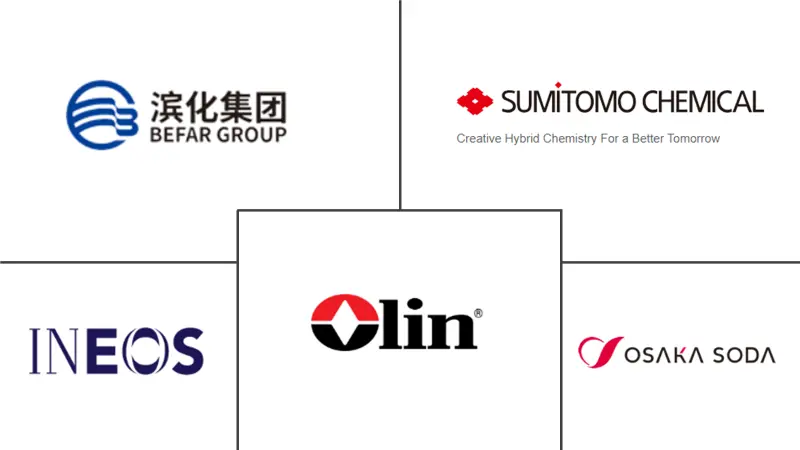Allyl Chloride Market Size and Share
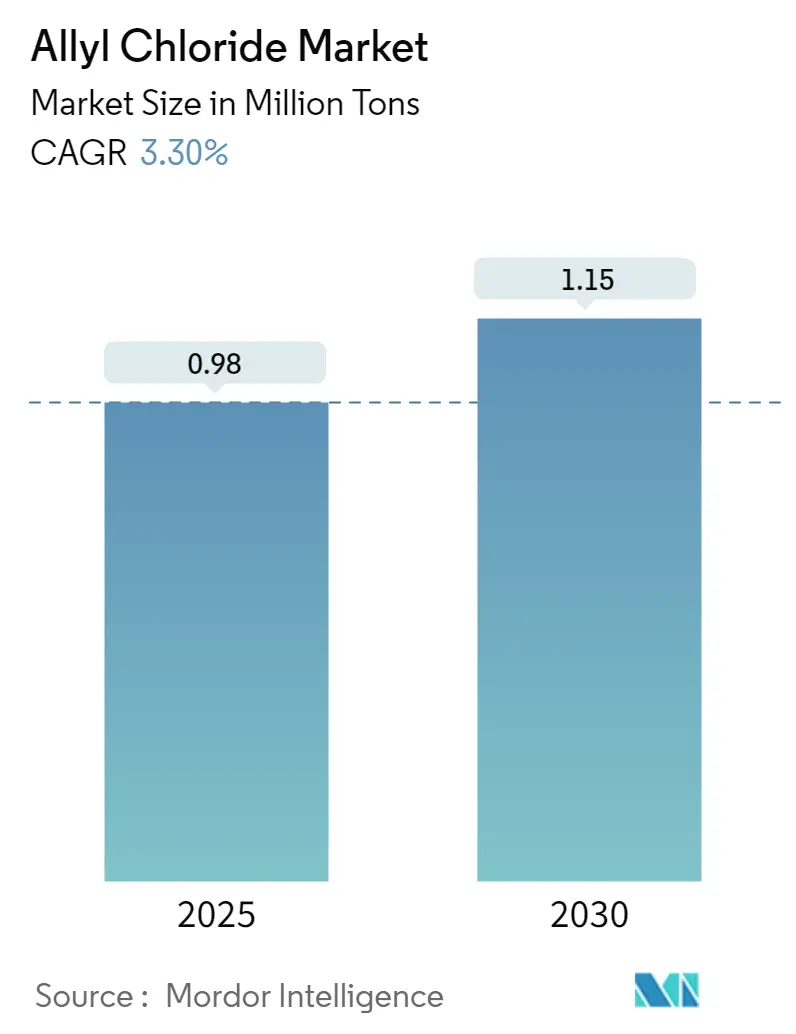
Allyl Chloride Market Analysis by Mordor Intelligence
The Allyl Chloride Market size is estimated at 0.98 million tons in 2025, and is expected to reach 1.15 million tons by 2030, at a CAGR of 3.3% during the forecast period (2025-2030).
The global allyl chloride industry is experiencing significant transformation driven by evolving end-user industry demands and technological advancements in manufacturing processes. The paints and coatings sector, a major consumer of allyl chloride derivatives, demonstrated robust growth with global sales volume reaching USD 179.9 billion in 2022, reflecting a 3.1% annual growth rate. This growth is particularly evident in emerging economies where rapid industrialization and infrastructure development are driving demand for epoxy resins and related products. The industry's landscape is further shaped by increasing vertical integration among major manufacturers, who are focusing on securing raw material supply chains and optimizing production efficiency.
The water treatment sector represents a crucial growth avenue for allyl chloride-based products, particularly in developed nations with stringent environmental regulations. In the United States alone, approximately 34 billion gallons of wastewater are processed daily, highlighting the massive scale of water treatment operations and the corresponding demand for treatment chemicals. The industry is witnessing a significant shift towards advanced treatment technologies and sustainable solutions, with numerous facilities upgrading their capabilities to meet increasingly stringent environmental standards. This trend is evidenced by major investments in water treatment infrastructure across various regions.
The pharmaceutical industry's robust growth has created substantial opportunities for pharmaceutical intermediates, with the global pharmaceutical market reaching USD 1.48 trillion in 2022. Major chemical companies are strategically positioning themselves to capitalize on this growth through strategic acquisitions and capacity expansions. For instance, in May 2023, Arkema strengthened its position by acquiring Polytec PT, enhancing its adhesives offering to industries including the fast-growing batteries and electronics market. Similarly, H.B. Fuller executed strategic acquisitions in June 2023, expanding its presence in both the United States and United Arab Emirates.
The specialty chemicals industry is witnessing significant capital investments in production capacity and technological advancement. A notable example is Sinopec's USD 1.56 billion project initiated in March 2023, which includes the construction of multiple facilities including a 100,000-tonne per annum epichlorohydrin unit. This trend of large-scale investments is accompanied by increasing focus on research and development activities, particularly in developing more efficient production processes and exploring new applications. The industry is also experiencing a wave of consolidation through mergers and acquisitions, as companies seek to strengthen their market positions and achieve economies of scale.
Global Allyl Chloride Market Trends and Insights
Growing Utilization of Allyl Chloride Derivatives in Several Applications
The expanding application scope of allyl chloride derivatives across multiple industries is driving significant market growth. Allyl chloride serves as a crucial chemical intermediate in various industries, including the preparation of polymers and other plastic materials, increased oil production, and the manufacture of pesticides, adhesives, chelating agents, detergents, flavorings, perfumes, pharmaceuticals, and urethanes. The compound's exceptional solubility in industrial solvents, despite being insoluble in water, makes it particularly valuable in industrial applications. According to the World Paint and Coatings Industry Association, the global sales volume of paints and coatings reached USD 179.9 billion in 2022, with an annual growth rate of 3.1%, demonstrating the robust demand for allyl compounds in coating applications.
The derivatives obtained from processing allyl chloride with other chemicals serve as vital components in various applications, particularly in the production of quaternary groups and water treatment chemicals. For instance, when allyl chloride is copolymerized with other vinyl monomers and reacted with trimethylamine, it forms polymers containing quaternary groups that are essential in water clarification and sewage sludge flocculation. The American Coatings Association reported that the production volume of paints and coatings in the United States reached approximately 1.36 billion gallons in 2022, witnessing a remarkable growth of about 38% compared to the previous year. This growth is further supported by significant industry developments, such as Arkema's acquisition of Polytec PT in May 2023, which strengthened Bostik's adhesives offering to industries, including the fast-growing batteries and electronics market. The company aims to achieve a turnover of USD 50 million for the Bostik department within the next five years through high-value applications by leveraging Arkema's global presence throughout all geographies.
Segment Analysis: Application
Epichlorohydrin Segment in Allyl Chloride Market
The epichlorohydrin segment continues to dominate the global allyl chloride market, commanding approximately 90% of the total market share in 2024. This substantial market presence is primarily attributed to the extensive use of epichlorohydrin in the production of epoxy resins, which are crucial components in the coatings, adhesives, and plastics industries. The segment's dominance is further strengthened by the growing demand from various end-use industries, particularly in the Asia-Pacific region where major manufacturers like Shandong Haili Chemical and Chang Chung Chemical have established significant production capacities. The segment's robust performance is also supported by increasing applications in the construction, automotive, and aerospace industries where epoxy resins are essential materials.
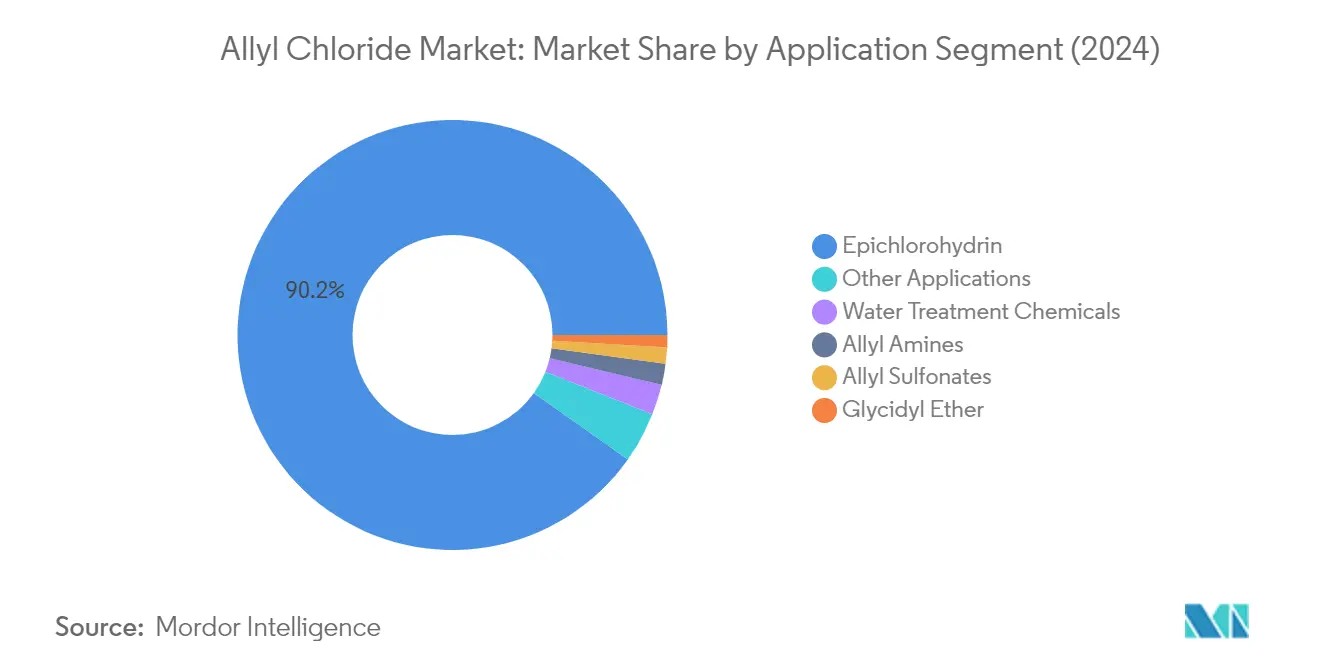
Water Treatment Chemicals Segment in Allyl Chloride Market
The water treatment chemicals segment is emerging as the fastest-growing application in the allyl chloride market, projected to expand at approximately 4% CAGR from 2024 to 2029. This growth is primarily driven by increasing global concerns regarding water scarcity and the rising need for efficient water treatment solutions. The segment's expansion is particularly notable in developing regions where rapid industrialization and urbanization are creating a surge in demand for water treatment facilities. The growth is further supported by stringent environmental regulations regarding water quality and the increasing adoption of advanced water treatment technologies across various industries. Recent developments in municipal water treatment projects, particularly in countries like China, India, and the Middle East, are expected to continue driving the segment's growth trajectory.
Remaining Segments in Application Segmentation
The remaining segments in the allyl chloride market include allyl amines, allyl sulfonates, glycidyl ether, and other applications such as adhesives, perfumes, and pharmaceuticals. Allyl amines play a crucial role in the production of pharmaceuticals and rubber chemicals, while allyl sulfonates are primarily used as metal brighteners in electroplating baths. The glycidyl ether segment serves specialized applications in the production of silicone compounds and processing agents for fibers and paper. These segments, though smaller in market share, contribute significantly to the market's diversity and serve specific industrial applications, particularly in the pharmaceutical, chemical processing, and manufacturing sectors. Additionally, the use of specialty chemicals and polymer additives in these segments highlights their importance as chemical intermediates and industrial solvents.
Allyl Chloride Market Geography Segment Analysis
Allyl Chloride Market in Asia-Pacific
The Asia-Pacific region represents the largest allyl chloride market globally, with countries like China, India, Japan, and South Korea leading in consumption. The region's dominance is attributed to the increasing production capacity of epichlorohydrin and growing utilization in water treatment applications. The presence of major manufacturers and an expanding industrial base, particularly in China and India, has strengthened the region's position in the global allyl chloride industry. The rising demand for water treatment chemicals and pharmaceutical intermediates has further accelerated market growth across the Asia-Pacific countries.
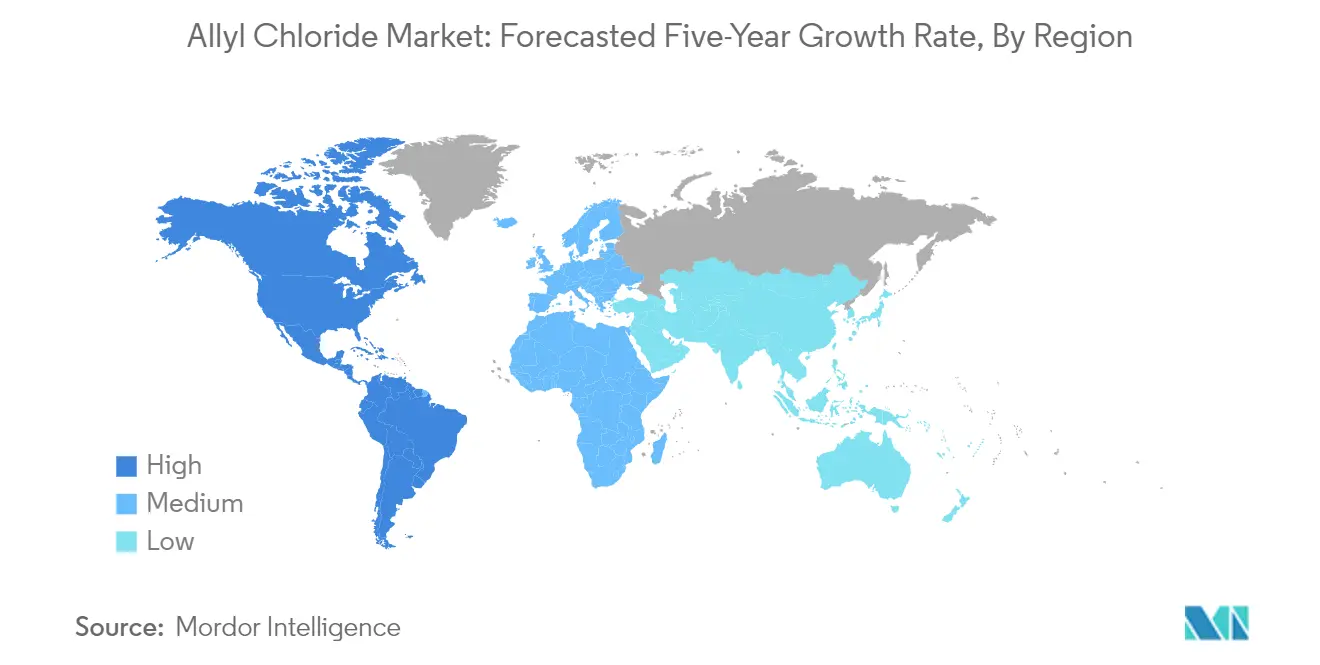
Allyl Chloride Market in China
China maintains its position as the largest allyl chloride market in Asia-Pacific, holding approximately 59% of the regional allyl chloride market share in 2024. The country's dominance is supported by its substantial epichlorohydrin production capacity, accounting for nearly 60% of Asia's total ECH output. The robust growth in China is driven by increasing investments in water treatment infrastructure and an expanding pharmaceutical sector. The country's focus on industrial development and growing demand from end-use industries like adhesives, water treatment, and pharmaceuticals continues to strengthen its market position.
Allyl Chloride Market in India
India emerges as the fastest-growing allyl chloride market in the Asia-Pacific region, with a projected growth rate of approximately 2% during 2024-2029. The country's market expansion is driven by government initiatives like 'Aatma Nirbhar Bharat' and 'Make in India' programs, which promote local manufacturing across various sectors. The increasing investments in water treatment projects and the growing pharmaceutical industry contribute significantly to market growth. India's focus on becoming self-reliant in various aspects of chemical manufacturing and the expansion of adhesive manufacturing facilities are expected to further boost the demand for chemical intermediates like allyl chloride in the coming years.
Allyl Chloride Market in North America
The North American allyl chloride market is characterized by strong technological advancement and established manufacturing infrastructure across the United States, Canada, and Mexico. The region's market is driven by robust demand from water treatment applications and the pharmaceutical industry. The presence of major manufacturers and ongoing investments in chemical manufacturing facilities contribute to the market's steady growth.
Allyl Chloride Market in United States
The United States dominates the North American allyl chloride market, accounting for approximately 84% of the regional allyl chloride market share in 2024. As one of the largest and most technologically advanced economies globally, the country has become a hotspot for adhesives, water treatment, pharmaceuticals, and ECH production. The presence of major manufacturers and ongoing investments in chemical manufacturing facilities has established the United States as a key player in the global allyl chloride market. The country's robust growth is further supported by an approximately 2% CAGR projected during 2024-2029, making it both the largest and fastest-growing market in North America.
Allyl Chloride Market in Europe
The European allyl chloride market demonstrates a strong presence across Germany, the United Kingdom, France, and Italy, supported by well-established chemical manufacturing infrastructure and stringent environmental regulations. The region's market is characterized by an increasing focus on sustainable production methods and growing demand from various end-use industries.
Allyl Chloride Market in Germany
Germany stands as the largest market for allyl chloride in Europe, with its advanced chemical manufacturing capabilities and strong industrial base. The country's dominance in the European market is supported by its robust water treatment technology sector and significant investments in pharmaceutical research and development. The presence of major chemical manufacturers and ongoing technological advancements further strengthens Germany's position in the market.
Allyl Chloride Market Growth in Germany
Germany also emerges as the fastest-growing market in Europe, driven by its increasing focus on environmental protection and efficient water treatment methods. The country's commitment to maintaining high water quality standards and growing investments in pharmaceutical research contribute to its market growth. The expansion of chemical manufacturing facilities and rising demand from various end-use industries continue to drive the market's development.
Allyl Chloride Market in South America
The South American allyl chloride market, comprising Brazil, Argentina, and other countries, shows steady development in chemical manufacturing capabilities. Brazil emerges as both the largest and fastest-growing market in the region, driven by its expanding water treatment infrastructure and growing pharmaceutical sector. The region's market growth is supported by increasing investments in water treatment projects and rising demand from various end-use industries.
Allyl Chloride Market in Middle East & Africa
The Middle East & Africa market for allyl chloride demonstrates growing potential across Saudi Arabia, South Africa, and other countries in the region. Saudi Arabia stands out as both the largest and fastest-growing market, supported by its robust chemical manufacturing sector and increasing investments in water treatment infrastructure. The region's market development is driven by growing industrialization and rising demand for water treatment chemicals.
Competitive Landscape
Top Companies in Allyl Chloride Market
The global allyl chloride market features established players like Olin Corporation, INEOS, Befar Group, and other prominent manufacturers who have built strong market positions through vertical integration and extensive distribution networks. Companies are increasingly focusing on sustainable production methods and bio-based alternatives while expanding their manufacturing capabilities to meet growing demand from end-use industries. Strategic initiatives include investments in research and development to improve production efficiency, reduce environmental impact, and develop innovative applications. Market leaders are strengthening their presence through capacity expansions, particularly in high-growth regions like Asia-Pacific, while also optimizing their supply chains to ensure reliable raw material sourcing and product delivery. The industry witnesses ongoing efforts to enhance product quality, develop value-added derivatives, and establish long-term partnerships with key customers across various sectors.
Fragmented Market with Regional Supply Dynamics
The allyl chloride market exhibits a fragmented structure where no single company holds a dominant market share, creating a competitive environment characterized by both global chemical conglomerates and specialized manufacturers. Major players maintain their competitive edge through vertical integration, controlling the entire value chain from raw material procurement to end-product distribution, while regional players focus on serving specific geographic markets or specialized applications. The industry's landscape is shaped by established relationships between manufacturers and end-users, particularly in sectors like epoxy resins, water treatment chemicals, and pharmaceuticals, with companies competing on factors such as product quality, pricing, technical support, and supply reliability.
Market consolidation remains limited, with companies preferring organic growth strategies over mergers and acquisitions. The industry structure is influenced by regional manufacturing capabilities, raw material availability, and proximity to key consumption centers, leading to the emergence of strong regional players alongside global manufacturers. Companies are increasingly establishing strategic partnerships and joint ventures to strengthen their market position, expand their product portfolio, and enhance their technological capabilities, while also focusing on developing sustainable production processes to meet evolving environmental regulations and customer preferences.
Innovation and Sustainability Drive Future Success
Success in the allyl chloride market increasingly depends on companies' ability to develop sustainable production processes, optimize operational efficiency, and expand their product applications portfolio. Market leaders are investing in advanced technologies to improve production yields, reduce energy consumption, and minimize environmental impact, while also focusing on developing bio-based alternatives to meet growing sustainability demands. Companies are strengthening their research and development capabilities to create innovative applications and value-added products, while building closer relationships with end-users to better understand and address their evolving needs.
Future market success will require companies to navigate regulatory challenges, particularly regarding environmental protection and safety standards, while maintaining cost competitiveness and supply chain reliability. Players must focus on developing efficient distribution networks, establishing strong customer relationships, and maintaining high product quality standards to differentiate themselves in the market. The ability to adapt to changing market dynamics, invest in sustainable technologies, and develop innovative solutions will be crucial for both established players and new entrants. Companies must also consider the growing threat of substitutes, particularly bio-based alternatives, and develop strategies to maintain their market position through product innovation and enhanced customer service. The specialty chemicals industry is increasingly looking towards chemical intermediates like allyl chloride to drive innovation in specialty chemicals and allyl compounds.
Allyl Chloride Industry Leaders
-
OSAKA SODA
-
Sumitomo Chemical Co., Ltd
-
INEOS
-
Olin Corporation
-
Befar Group Co. Ltd.
- *Disclaimer: Major Players sorted in no particular order
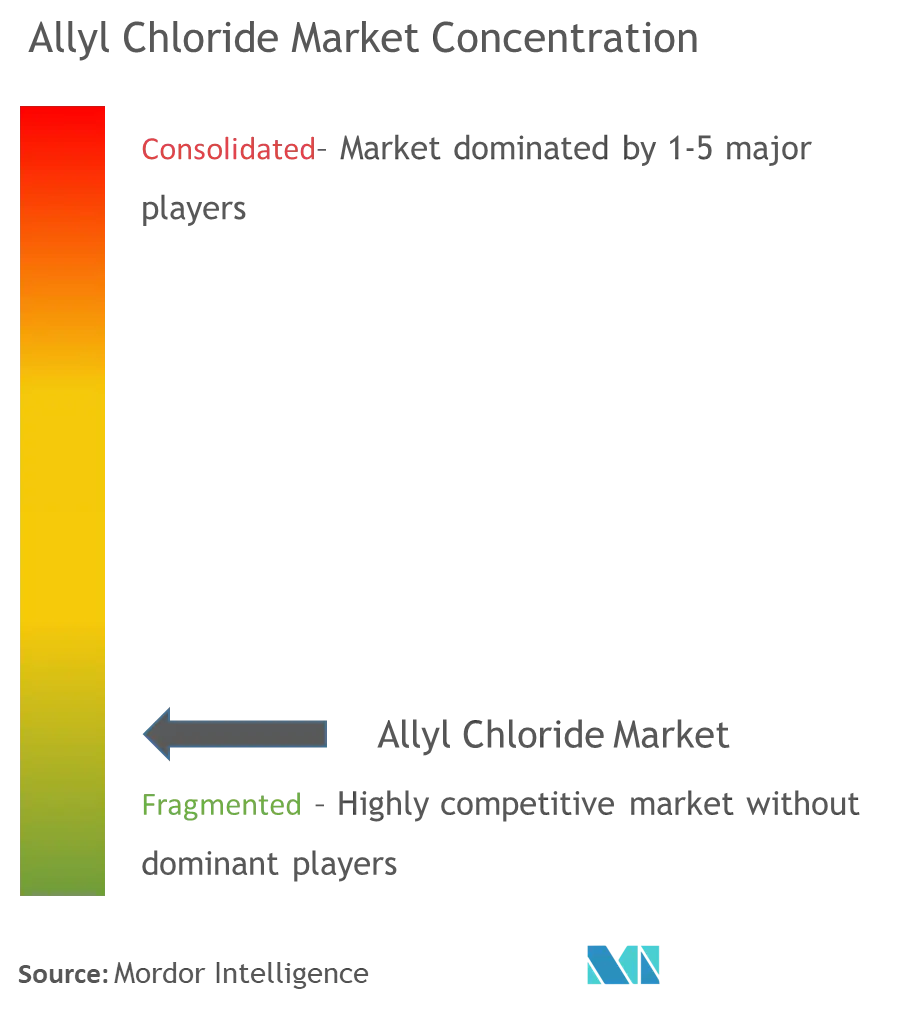
Recent Industry Developments
March 2023: INOVYN, a leading UK-based chemical company, launched an innovative product in the allyl chloride segment by introducing a sustainable, bio-based variant. This new product aims to address environmental concerns and cater to the growing demand for eco-friendly chemical solutions.
Global Allyl Chloride Market Report Scope
Allyl chloride is an organochlorine compound. It is mainly converted to epichlorohydrin, used in the production of plastics.
The allyl chloride market is segmented by application and geography. By application, the market is segmented into allyl amines, allyl sulfonates, epichlorohydrin, glycidyl ether, water treatment chemicals, and others (adhesives, perfumes, and pharmaceuticals). The report also covers the market size and forecasts for the allyl chloride market in different countries across major regions, including North America, Europe, Asia-Pacific, Latin America, the Middle East, and Africa.
For each segment, the market sizing and forecasts have been done in volume (kilotons).
| Allyl Amines |
| Allyl Sulfonates |
| Epichlorohydrin |
| Glycidyl Ether |
| Water Treatment Chemicals |
| Other Applications (Adhesives, Perfumes, Pharmaceuticals) |
| Asia-Pacific | China |
| India | |
| Japan | |
| South Korea | |
| Rest of Asia-Pacific | |
| North America | United States |
| Canada | |
| Mexico | |
| Europe | Germany |
| United Kingdom | |
| France | |
| Italy | |
| Rest of Europe | |
| South America | Brazil |
| Argentina | |
| Rest of South America | |
| Middle-East and Africa | Saudi Arabia |
| South Africa | |
| Rest of Middle-East and Africa |
| Application | Allyl Amines | |
| Allyl Sulfonates | ||
| Epichlorohydrin | ||
| Glycidyl Ether | ||
| Water Treatment Chemicals | ||
| Other Applications (Adhesives, Perfumes, Pharmaceuticals) | ||
| Geography | Asia-Pacific | China |
| India | ||
| Japan | ||
| South Korea | ||
| Rest of Asia-Pacific | ||
| North America | United States | |
| Canada | ||
| Mexico | ||
| Europe | Germany | |
| United Kingdom | ||
| France | ||
| Italy | ||
| Rest of Europe | ||
| South America | Brazil | |
| Argentina | ||
| Rest of South America | ||
| Middle-East and Africa | Saudi Arabia | |
| South Africa | ||
| Rest of Middle-East and Africa | ||
Key Questions Answered in the Report
How big is the Allyl Chloride Market?
The Allyl Chloride Market size is expected to reach 0.98 million tons in 2025 and grow at a CAGR of 3.30% to reach 1.15 million tons by 2030.
What is the current Allyl Chloride Market size?
In 2025, the Allyl Chloride Market size is expected to reach 0.98 million tons.
Who are the key players in Allyl Chloride Market?
OSAKA SODA, Sumitomo Chemical Co., Ltd, INEOS, Olin Corporation and Befar Group Co. Ltd. are the major companies operating in the Allyl Chloride Market.
Which is the fastest growing region in Allyl Chloride Market?
Europe is estimated to grow at the highest CAGR over the forecast period (2025-2030).
Which region has the biggest share in Allyl Chloride Market?
In 2025, the Asia Pacific accounts for the largest market share in Allyl Chloride Market.
What years does this Allyl Chloride Market cover, and what was the market size in 2024?
In 2024, the Allyl Chloride Market size was estimated at 0.95 million tons. The report covers the Allyl Chloride Market historical market size for years: 2019, 2020, 2021, 2022, 2023 and 2024. The report also forecasts the Allyl Chloride Market size for years: 2025, 2026, 2027, 2028, 2029 and 2030.
Page last updated on:
